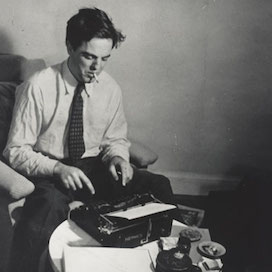(Continued from previous page)
On a subsequent trip to New York City a month later, I had been bouncing around record stores for the better part of a day when I landed upon A1 Records—an esteemed shop in the East Village. I walked through the door and headed straight for the jazz section in the back. But before I purged the bins, I quickly glanced up at the wall, and resting there in a small metal support frame was an original 1964 mono pressing of BLP 4178, Blue Mitchell’s The Thing to Do. The two-tone cover’s close-up of Blue’s hands clutching his horn instantly fixated me. I frantically yet cautiously approached the record, paranoid that someone might dart out in front of me and snatch it up before I had the chance to. I pulled it down off the shelf for examination. It was in much better condition than the other records I had come across. It was a little more expensive too, but that didn’t stop me from promptly delivering it to the clerk behind the counter.
When I got home later that night, I rushed upstairs to my listening station, hurriedly removed the record from the jacket, placed it on the turntable, and quickly but carefully dropped the needle into the groove. As I adjusted the volume on my amplifier, I nervously awaited the first blast of the horns, praying I wouldn’t hear that fuzzy, smeared sound I had unwillingly grown so accustomed to. The repetitive, light crackle of the lead-in groove sounded for what felt like an eternity.
But when the brass finally came in, I knew right away that I was listening to that sound I had come to believe only existed in legend, and I was in complete agreement with the web’s faux-experts. Studio engineer Rudy Van Gelder’s straight-down-the-middle mono mix had the instruments in perfect balance, packing a dynamic punch that digital stereo remasters are simply incapable of. I had immediately been converted to a true believer, and I soon returned to feverishly bidding on eBay.
Knowing there was never any shortage of collectors ready to pay exorbitant amounts of money for these records, I knew I had to step my game up: if I wanted to have a fighting chance at winning some auctions, I needed to increase my budget. I then proceeded to bid on a slew of records. I scored many victories but suffered many more defeats, and after months of bidding, returning, and reselling dozens of records, I had learned the hard way that “VG+” is a highly subjective grade in the record collecting community, open to a wide variety of interpretations. The experience naturally caused me to raise my standards, and I only kept a handful of the records I had originally won.
At this point I knew I’d have to spend even more money if I wanted to stay in the game, and the hobby was beginning to try my patience. I felt a bit exhausted by the whole thing, but I wanted to continue exploring the vast universe of classic jazz. I decided to hit the local libraries again, and soon enough I had a respectable collection of classic jazz albums on my computer. As I settled into an effortless routine of listening on my various digital devices though, something didn’t feel right. The sound was as flawless and crystal-clear as I had always known digital to be, yet the experience somehow felt hollow and incomplete.
In all the years I had been collecting records, I honestly never understood when audiophiles argued that vinyl was sonically superior to the pinpoint precision of digital. But something finally resonated with me and I felt like I understood what they meant when they said digital was nothing more than a “ghost in the machine”. This certainly was not the type of scientific sentiment that would usually speak to a logical thinker like me, and I was surprised to find myself identifying with the analog enthusiasts and their passionate philosophy of listening. There was no question in my mind anymore that I too preferred the vinyl listening experience. But I didn’t want any run-of-the-mill modern reproductions. I wanted records that were as old and wondrous as the music they contained—I wanted the true and authentic experience of vintage vinyl.
Any honest, experienced collector of vintage jazz records will warn you of the sacrifice and commitment necessary to experience the highest of highs this hobby has to offer. But nothing beats the thrill of finding a rare, original pressing of one of your favorite albums after months or even years of dedicated search (especially if you get it for a good price), or hearing a record that has survived a half a century of ownership changes to get to you but still sounds like it came from the store yesterday. Despite all the returns, the empty-handed trips home from the record store, and the indecision that comes along with taking part in a hobby that is barely within your means, the joy and satisfaction that ultimately come from collecting vintage jazz vinyl make it all worth it.

